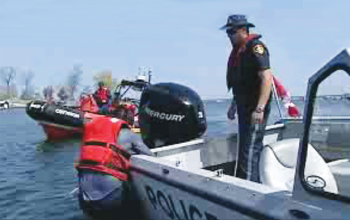The 1-10-1 Rule and the Importance of the PFD in Surviving
Cold Water Immersion
by Ann Backus, MS

The US Coast Guard and certified marine safety instructors often introduce the 1-10-1 Rule to help all of us understand what happens to our bodies during cold water immersion. The 1-10-1 Rule was developed by Gordon Giesbrecht, PhD, a professor of thermophysiology, who studies how the human body reacts to extreme temperature conditions.
Many of us, fishermen and non-fishermen alike, have experienced the effects of falling into or jumping into cold water. We recognize that we are stunned or shocked by that initial contact with cold water, and when we pop-up to the surface we feel out of breathe or find it hard to catch our breath.

During the incapacitation stage, muscular functions decrease. If holding on to a boat or other floating object, gradually the ability to grasp it is lost. This condition, not hypothermia, is believed to be the cause of drowning.
As a student of physiology, myself, back in the day, I decided one sunny day to see how long I could swim in the ocean near Friendship, Maine before I felt really uncomfortable, tired, and barely able to move the muscles I needed for swimming. The water was not all that cold as cold water goes, perhaps 65°F. I actually don’t remember now, how long I was swimming for, but when I did walk to shore, I was decidedly weak and spent the rest of the afternoon shivering.
Dr. Giesbrecht, in his Laboratory for Exercise and Environmental Medicine at the University of Manitoba, has devised and implemented many experimental protocols in order to explore how the human body reacts to cold water immersion. From these experiments, he developed the 1-10-1 Rule.
The 1-10-1 Rule
It is not hypothermia
that is the cause
of drowning.
The purpose of this rule is to 1) help us remember the stages of physiological change that our bodies go through when introduced to cold water and 2) to introduce behaviors or responses that may help us survive each of the stages.
1 – Cold shock. Usual duration – one minute. The initial shock to the body of cold water causes us to gasp for air and breathe rapidly. To survive this stage, do not panic, keep your head above water and concentrate on getting control of your breathing.
10 – Cold Incapacitation. Duration – roughly ten minutes. During this stage, muscular functions decrease. If, for example you were holding on to a boat or other floating object you would gradually lose the ability to grasp it. To increase your chances for survival and rescue during this stage, take steps to save yourself: Position yourself on a floating object such as an overturned boat, release some dye into the water, yell or wave your arms, or if you have thought ahead and put your cell phone in a waterproof pouch, try an emergency phone call.
1 – Hypothermia. Duration one hour, approximately. Hypothermia will set in faster if the water is cold, your clothes cannot insulate you, you are totally immersed in the water, and if you are of lean body mass. As hypothermia progresses you slowly lose consciousness and eventually your heart will stop beating. To slow down the development of hypothermia take the H.E.L.P position (heat escape lessening position – knees to chest), or huddle with others. Try to climb on something that will keep you out of the water. Shivering is a good sign, as it produces heat in your muscles.
It is Dr. Giesbrecht’s position that it is not hypothermia that is the cause of drowning, but the failure to survive either minute one – the Cold Shock, or the next ten or so minutes – Cold Incapacitation.
Enter the PFD
The PFD keeps your head
above water, allowing you
to focus on getting control
of your breathing.
The Personal Flotation Device, or life jacket, is potentially a life-saving aid during cold water immersion. It plays a role in each of the three stages. During the Cold Shock stage, the PFD keeps your head above water, allowing you to focus on getting control of your breathing rather than spend mental and physical energy trying to stay afloat. During the Cold Incapacitation stage, the PFD supports your body as you try to use the precious minutes you have in this stage to signal help or reposition yourself on a floating object. The PFD also provides support when your muscles lose their ability to keep you afloat or keep you hanging on to a buoy or boat.
In the Hypothermia stage, the PFD may provide some extra insulation and may enable you to swim a short distance. In his video at http://www.coldwaterbootcamp.com/pages/1_10_60v2.html, Dr. Giesbrecht mentions that you should stay with the boat if at all possible and certainly not attempt to swim unless you are wearing a PFD. His research shows that we tend to overestimate our ability to swim a distance and underestimate the distance to shore or a safer perch.
Lifejackets for Lobstermen
I hope that many of you reading this will have taken advantage of Lifejackets for Lobstermen when the van came to your harbor or port this summer. Staff of the Northeast Center (NEC) for Occupational Safety and Health has spent over 8 months travelling to ports and harbors in Maine and Massachusetts offering a wide variety of lifejackets to try on and offering discounted prices. If you missed them, you may have a final opportunity during the month of October. Please check out the notice in this month’s Fishermen’s Voice. For updates on ports that the Lifejackets for Lobstermen van will visit in October please check out the Face Book page - https://www.facebook.com/LifejacketsforLobstermen.
After reading this article, I hope you are persuaded that your survival of a man overboard or other immersion incident depends on two key elements: 1) understanding the 1-10-1 Rule and 2) wearing a PFD or life-jacket that allows you to respond appropriately to the physiological changes that take place during cold water immersion.
Ann Backus, MS is an Instructor in Occupational Health at Harvard School of Public Health, 665 Huntington Ave., Boston MA 02 5, 617-432-3327, abackus@hohp.harvard.edu.
